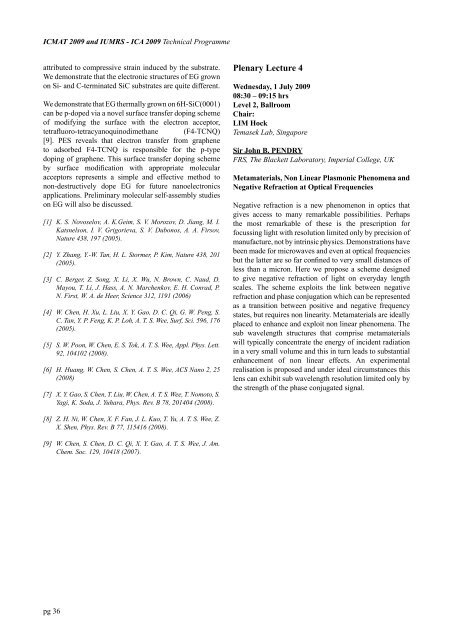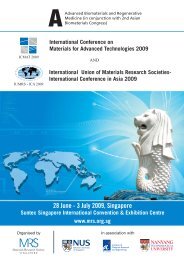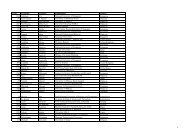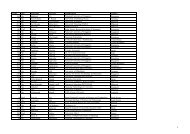Technical Programme - Materials Research Society of Singapore ...
Technical Programme - Materials Research Society of Singapore ...
Technical Programme - Materials Research Society of Singapore ...
You also want an ePaper? Increase the reach of your titles
YUMPU automatically turns print PDFs into web optimized ePapers that Google loves.
ICMAT 2009 and IUMRS - ICA 2009 <strong>Technical</strong> <strong>Programme</strong><br />
attributed to compressive strain induced by the substrate.<br />
We demonstrate that the electronic structures <strong>of</strong> EG grown<br />
on Si- and C-terminated SiC substrates are quite different.<br />
We demonstrate that EG thermally grown on 6H-SiC(0001)<br />
can be p-doped via a novel surface transfer doping scheme<br />
<strong>of</strong> modifying the surface with the electron acceptor,<br />
tetrafl uoro-tetracyanoquinodimethane (F4-TCNQ)<br />
[9]. PES reveals that electron transfer from graphene<br />
to adsorbed F4-TCNQ is responsible for the p-type<br />
doping <strong>of</strong> graphene. This surface transfer doping scheme<br />
by surface modifi cation with appropriate molecular<br />
acceptors represents a simple and effective method to<br />
non-destructively dope EG for future nanoelectronics<br />
applications. Preliminary molecular self-assembly studies<br />
on EG will also be discussed.<br />
[1] K. S. Novoselov, A. K.Geim, S. V. Morozov, D. Jiang, M. I.<br />
Katsnelson, I. V. Grigorieva, S. V. Dubonos, A. A. Firsov,<br />
Nature 438, 197 (2005).<br />
[2] Y. Zhang, Y.-W. Tan, H. L. Stormer, P. Kim, Nature 438, 201<br />
(2005).<br />
[3] C. Berger, Z. Song, X. Li, X. Wu, N. Brown, C. Naud, D.<br />
Mayou, T. Li, J. Hass, A. N. Marchenkov, E. H. Conrad, P.<br />
N. First, W. A. de Heer, Science 312, 1191 (2006)<br />
[4] W. Chen, H. Xu, L. Liu, X. Y. Gao, D. C. Qi, G. W. Peng, S.<br />
C. Tan, Y. P. Feng, K. P. Loh, A. T. S. Wee, Surf, Sci. 596, 176<br />
(2005).<br />
[5] S. W. Poon, W. Chen, E. S. Tok, A. T. S. Wee, Appl. Phys. Lett.<br />
92, 104102 (2008).<br />
[6] H. Huang, W. Chen, S. Chen, A. T. S. Wee, ACS Nano 2, 25<br />
(2008)<br />
[7] X. Y. Gao, S. Chen, T. Liu, W. Chen, A. T. S. Wee, T. Nomoto, S.<br />
Yagi, K. Soda, J. Yuhara, Phys. Rev. B 78, 201404 (2008).<br />
[8] Z. H. Ni, W. Chen, X. F. Fan, J. L. Kuo, T. Yu, A. T. S. Wee, Z.<br />
X. Shen, Phys. Rev. B 77, 115416 (2008).<br />
[9] W. Chen, S. Chen, D. C. Qi, X. Y. Gao, A. T. S. Wee, J. Am.<br />
Chem. Soc. 129, 10418 (2007).<br />
pg 36<br />
Plenary Lecture 4<br />
Wednesday, 1 July 2009<br />
08:30 – 09:15 hrs<br />
Level 2, Ballroom<br />
Chair:<br />
LIM Hock<br />
Temasek Lab, <strong>Singapore</strong><br />
Sir John B. PENDRY<br />
FRS, The Blackett Laboratory, Imperial College, UK<br />
Metamaterials, Non Linear Plasmonic Phenomena and<br />
Negative Refraction at Optical Frequencies<br />
Negative refraction is a new phenomenon in optics that<br />
gives access to many remarkable possibilities. Perhaps<br />
the most remarkable <strong>of</strong> these is the prescription for<br />
focussing light with resolution limited only by precision <strong>of</strong><br />
manufacture, not by intrinsic physics. Demonstrations have<br />
been made for microwaves and even at optical frequencies<br />
but the latter are so far confi ned to very small distances <strong>of</strong><br />
less than a micron. Here we propose a scheme designed<br />
to give negative refraction <strong>of</strong> light on everyday length<br />
scales. The scheme exploits the link between negative<br />
refraction and phase conjugation which can be represented<br />
as a transition between positive and negative frequency<br />
states, but requires non linearity. Metamaterials are ideally<br />
placed to enhance and exploit non linear phenomena. The<br />
sub wavelength structures that comprise metamaterials<br />
will typically concentrate the energy <strong>of</strong> incident radiation<br />
in a very small volume and this in turn leads to substantial<br />
enhancement <strong>of</strong> non linear effects. An experimental<br />
realisation is proposed and under ideal circumstances this<br />
lens can exhibit sub wavelength resolution limited only by<br />
the strength <strong>of</strong> the phase conjugated signal.






